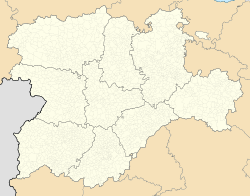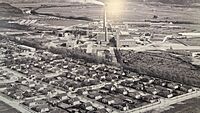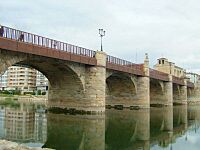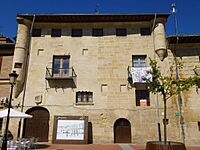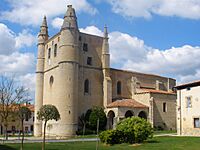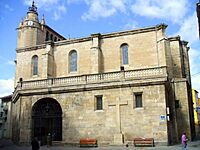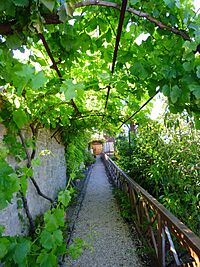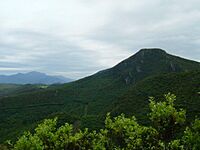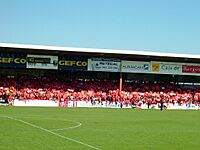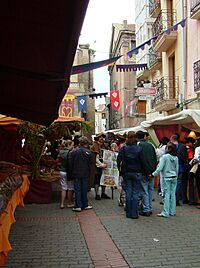Miranda de Ebro facts for kids
Quick facts for kids
Miranda de Ebro
|
|||
|---|---|---|---|
|
Municipality and town
|
|||
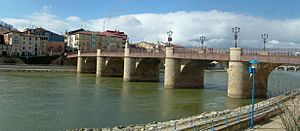 |
|||
|
|||
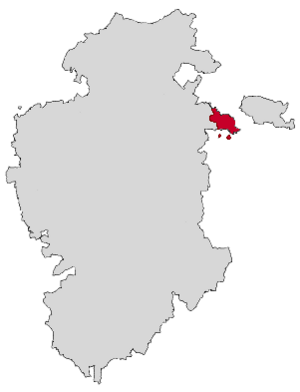
Location of Miranda de Ebro in the province of Burgos
|
|||
| Country | |||
| Autonomous community | |||
| Province | |||
| Comarca | Comarca del Ebro | ||
| Area | |||
| • Total | 101.33 km2 (39.12 sq mi) | ||
| Elevation | 471 m (1,545 ft) | ||
| Population
(2018)
|
|||
| • Total | 35,477 | ||
| • Density | 350.113/km2 (906.79/sq mi) | ||
| Demonym(s) | Mirandeses | ||
| Time zone | UTC+1 (CET) | ||
| • Summer (DST) | UTC+2 (CEST) | ||
| Postal code |
09200
|
||
Miranda de Ebro is a city located in Spain. It sits on the Ebro river in the province of Burgos. This area is part of the Castile and León region. The city is in the northeast of the province, near the borders of Álava and La Rioja.
In 2018, Miranda de Ebro had about 35,477 people living there. This makes it the second largest city in the Burgos province, after the capital city of Burgos. The city's economy is mostly industrial, especially known for its chemical factories. It is also a very important place for transportation, especially for trains. Major cities like Bilbao, Burgos, Logroño, and Vitoria-Gasteiz are all within 80 kilometers (about 50 miles).
Contents
Where is Miranda de Ebro?
Miranda de Ebro is in the northeastern part of the province of Burgos. It is about 80 kilometers (50 miles) from the capital city. The city's exact location is 42° 41′ 6″ North and 2° 55′ 60″ West. It covers an area of about 101.33 square kilometers (39.12 square miles). The city is 471 meters (1,545 feet) above sea level.
The Ebro river flows through the city, dividing it into two main parts. The older part is called Aquende, and the newer part is called Allende.
A Look at Miranda de Ebro's Past
People first settled in this area during the Iron Age. Ancient Roman ruins of a city called Deóbriga are found just 3 kilometers (about 2 miles) from Miranda. Other Roman ruins are also in nearby towns.
The name Miranda de Ebro first appeared in a document called the Codex Vigilanus in 757. This document mentioned Miranda as a place that had been destroyed.
In 1076, Miranda de Ebro became part of the Kingdom of Castile. This happened after the death of Sancho IV of Navarre. To make his rule stronger, King Alfonso VI of Castile gave Miranda de Ebro a special set of laws called a fuero in 1099.
In 1254, King Alfonso X of Castile allowed a May fair to be held in the city. This helped trade grow. Later, in 1332, King Alfonso XI of Castile added a March fair. Miranda de Ebro has had a bridge over the Ebro river since at least the 10th century. This bridge, along with the special laws, made Miranda de Ebro an important trading center for a long time.
During the 14th and 15th centuries, the town changed hands several times. It finally returned to the control of Burgos in 1493, where it has stayed ever since.
The arrival of the railway in 1862 changed the city a lot. It brought the start of the industrial revolution. Miranda became a very important train junction in northern Spain. This was because lines from Madrid to Irun and Castejón to Bilbao met there.
In 1907, King Alfonso XIII of Spain officially made Miranda a city.
During the Spanish Civil War and World War II, Miranda de Ebro was the site of a special camp. This camp was active until 1947. Many people, both Spanish and from other countries, were held there.
Since 1992, Miranda de Ebro has been a twin city with Vierzon, France. In 1999, a big celebration took place to mark 900 years since Miranda received its special laws.
What is Miranda de Ebro's Economy Like?
The city's economy has changed over time. Farming, especially growing grain, is still important. Other types of farming, like irrigated crops and viticulture (grape growing), are less common. In the past, raising cattle and horses was very important. This is why the city has had fairs since the 16th century. There are also limestone quarries near the city.
Miranda de Ebro is a strong industrial city because of its great location. It is close to the Basque Country and La Rioja. The industrial growth began when the railway arrived in 1862. In the early 1900s, a sugar plant became the first big factory (1925). Later, FEFASA (1948) started making paper products. In the mid-1900s, many chemical companies opened.
In 1969, the first industrial area called Bayas was planned. Many businesses started there in 1981. This led to many more projects for industry and trade in the city. Other companies in the area make food, airplane parts, and iron and steel products.
Today, traditional shops have been joined by new businesses and places for fun. Large companies like E.Leclerc and Inditex have stores in the city.
The latest information from 2008 showed that Miranda de Ebro had 39,586 people. After a small drop in population in the 1990s, the city has grown each year. This is partly because people from nearby Álava have moved there looking for more affordable homes. The number of people from other countries has also increased.
How Do People Get Around in Miranda de Ebro?
Miranda de Ebro is a key place for transportation. This is because of its location between the northern plateau, the Ebro Valley, and the Basque region. It is especially important for train travel.
Travel Between Cities
Many national roads, highways, and motorways pass through Miranda de Ebro. These roads connect the city to all the major cities nearby. New highways are being planned to connect Miranda to Aragón and the Cantabrian coast.
The Miranda de Ebro railway station is considered a top-level station in Spain. Two major train lines meet there. Since 2007, the city has had high-speed train service to major provincial capitals. Miranda also has an important center for sorting goods by train. The main control center for train traffic in northern Spain is located in Miranda.
A new bus station is planned for the city center, close to the train station.
Miranda de Ebro does not have its own airport. However, Vitoria Airport is only 35 kilometers (about 22 miles) away. You can reach it in less than half an hour by highway. Other airports nearby include Bilbao Airport, Burgos Airport, and Logroño-Agoncillo Airport.
Getting Around Locally
A bus system operates one route within the city. New bus lines are expected soon.
Miranda de Ebro also has taxis that can take you to Vitoria or the train station. In recent years, the city has been building a network of bicycle lanes. These lanes are expected to be about 27 kilometers (17 miles) long. Since 2008, the city has also offered a bike rental service called Biciudad Miranda.
What to See in Miranda de Ebro
Interesting Buildings and Structures
- Carlos III Bridge: This bridge was built in 1777. It has 6 arches and special parts at each end to help with river waves. Since 1786, two lion statues have guarded the bridge. One holds the royal shield, and the other holds the city's shield.
- City Hall: The current City Hall building has been in the Plaza de España since 1778. It was designed in a neoclassic style.
- Castle of Miranda de Ebro: Only a few walls of this castle remain today. It was built in the 14th century and was used until the 1800s. Much of its stone was later used for other buildings.
- Old Mansions: Many old mansions are found in Miranda de Ebro. The House of Chains (Casa de las Cadenas) from the 16th century hosted important people like Joseph, brother of Napoleon Bonaparte. Another notable building is the Urbina House (Casa de los Urbina), also from the 16th century. It has defensive towers and hosted King Philip IV of Spain.
- Railway Station: Built in 1862 by English architect Charles Vignoles, this is one of the oldest train stations in northern Spain. It is where two major train lines meet. Its iron parts were made in London.
- Apollo Theatre: This theater was built in 1921. It has interesting historicist decorations, like busts and plants.
- La Picota: This stone pillar was carved in 1569. In the past, it was a symbol of judicial power in the village.
- Plaza de Abastos: This market building opened in 1917 in the city center. It is known for its strong construction and Islamic-style details.
- Old Convent of the Three Kings Augustinian Recollects: This building was first a chalet built in 1911. Later, it became a convent with a chapel. It has a pyramid-shaped tower and stone walls. Since 1998, it has belonged to the Government of Castile and León.
Churches and Religious Sites
- Church of the Holy Spirit: This church is mentioned in the 1099 Miranda Charter. Its front and apse are from the 13th century. Its small Gothic nave is from the 16th century.
- Saint Mary's Church: Built in the 16th century, this church combines Late Gothic and Renaissance styles.
- Church of the Sacred Hearts: Located in the old convent of San Francisco, this church was built in the 16th century. It is known for its baroque-style steeple from 1693.
- Old Church of Saint John: This church has been in ruins since 1875. However, some parts of its decorated naves and windows are still preserved.
- St. Nicholas's Church: Built in 1945, this church has three large naves and a big rose window. Inside, you can see large tapestries painted by Manuel Navarro and his brother.
Parks and Green Spaces
Miranda de Ebro has been working to create more green areas. In 2009, the city had over 646,000 square meters (about 160 acres) of green spaces. This means about 16.35 square meters (176 square feet) of green space for each person.
- Antonio Machado Park: Built in 1915, this is the most central park in Miranda de Ebro. It covers 12,500 square meters (about 3 acres). The park mixes French and English garden styles. It has a kiosk with a cupola and monuments to the Municipal Band and the Miranda Charter.
- Miranda de Ebro Botanical Garden: This garden is next to an old convent. It covers about 2,400 square meters (about half an acre) on the slopes of La Picota. The garden has 700 different types of plants. Each plant is labeled with its common name, scientific name, and where it comes from.
Sports in Miranda de Ebro
Most of Miranda de Ebro's sports facilities are at the Anduva Municipal MultiSports center. This center has tennis courts, indoor and outdoor pools, multi-sport fields, a gym, a running track, and soccer fields. Other sports places include the Anduva Municipal Stadium for soccer, and the Ebro Pavilion. The city also has tracks for kart racing and motocross, and a field for model airplanes.
Sports Teams
- Club Deportivo Mirandés: This is a soccer team started in 1927. Mirandés plays in the Spanish second division. Their home field is the Anduva Municipal Stadium. Their fans are known as the "marea rojilla," which means "red tide."
- Club Voley Miranda: This was a volleyball club that competed in the Women's Superleague 2.
Sporting Events
- Cross National Prince of Spain
- Motos concentration
- Vuelta a Burgos (a cycling race)
Celebrations and Events
Miranda de Ebro hosts many celebrations and fairs throughout the year.
- March Fair or Fair of the Angel: This fair is held on March 1st and has been celebrated since the 14th century.
- May Fair: This fair takes place on the first weekend of May. Since 1997, it has been held at the same time as the Medieval market.
The biggest celebration in Miranda de Ebro is the Saint John of the Mountain Festival. It is held on Whit Monday on the Monte de San Juan. This festival has a parade that is considered one of the best in Northern Spain. Also, September 12th is the day of the city's patron saint, the Virgin of Altamira. This event includes float competitions, concerts, and fireworks.
Education
- Colegio Sagrados Corazones
Twin Cities
See also
 In Spanish: Miranda de Ebro para niños
In Spanish: Miranda de Ebro para niños




